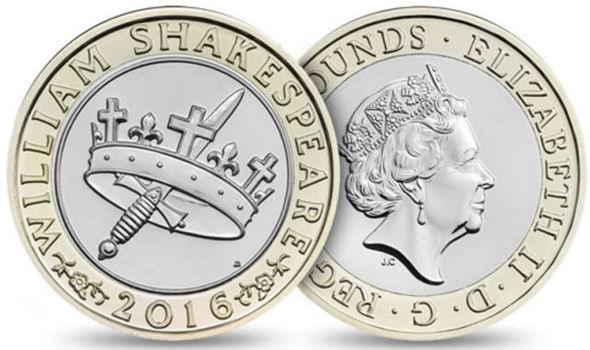The Shakespeare Histories £2 coin is part of a trio of coins issued by the Royal Mint in 2016 to commemorate the 400th anniversary of the death of the legendary playwright, William Shakespeare.
Often referred to as the Crown and Dagger £2 coin, this coin draws inspiration from Shakespeare’s famous histories.
Designed by artist John Bergdahl, this coin draws inspiration from one of Shakespeare’s most famous history plays: “Macbeth.”
The reverse side features a striking design of a crown and a dagger, symbolizing the regal power and intrigue found in Shakespeare’s historical works.
Let's take a closer look at this intriguing two pound coin.
History of the coin
The Shakespeare Histories £2 coin was minted in 2016 to commemorate the 400th anniversary of the death of the renowned playwright and poet, William Shakespeare.
William Shakespeare was born in the picturesque town of Stratford-Upon-Avon. His christening took place on the 26th of April, 1564, though the exact day of his birth remains a mystery. Shakespeare is widely acclaimed as one of the most eminent poets and playwrights in history.
During his life, he wrote 154 sonnets and 37 plays, like Macbeth, Hamlet, Romeo and Juliet, and A Midsummer Night's Dream. Shakespeare passed away on April 23, 1616 at 52.
Design of the coin
The reverse side of the coin showcases a crown and a dagger. The crown symbolises regal power, authority, and the monarchy. The dagger represents intrigue, betrayal, and the darker aspects of Shakespeare’s historical works.
The talented artist John Bergdahl skillfully crafted this design, capturing the essence of Shakespearean drama. The imagery evokes the tension, ambition, and treachery found in the play “Macbeth.”

The reverse side showcases a dagger through a hollow crown with the name 'WILLIAM SHAKESPEARE' and the year '2016' running round.
Encircling the milled edge, you’ll find the inscription: “THE HOLLOW CROWN.” This phrase alludes to the concept of kingship, the weight of responsibility, and the fragility of power.
The obverse of each coin shows the fifth portrait of Queen Elizabeth II, designed by Jody Clark. This is the first time the portrait has been used on £2 coins, having only been unveiled in 2015.

Surrounding her head all around the outer circle is her legendary ELIZABETH II D G REG F D 2 POUNDS which translates from Latin to mean Elizabeth the Second, by the Grace of God, Queen, Defender of the Faith.
Designed by Royal Mint engraver, Jody Clark, the fifth definitive UK coin portrait features a bust of Queen Elizabeth II wearing the King George IV State Royal Diamond Diadem Crown, which she wore for her Coronation in 1953.
Jody Clark chose this to link his design to the past as it was featured in the designs by both Raphael Maklouf and Arnold Machin. The Queen is also wearing the Diamond Jubilee drop pearl earring 's and her chin is lifted slightly.
Mintage of the Coin
The Shakespeare Histories £2 coin has a mintage of 5,655,000, making it the highest minted among the three Shakespeare coins. While this mintage is not exceptionally low for a £2 coin, its allure lies in its connection to Shakespeare’s wit and laughter. Collectors seek out this coin not only for its scarcity but also for its thematic resonance.
The 2016 Shakespeare Comedies £2 Coin had a mintage of 4,355,000 and the 2016 Shakespeare Tragedies £2 Coin, slightly more at 4,615,000.
Other £2 coins released into circulation that year include the 2016 Great Fire of London £2 coin with a relatively low mintage of 1,625,000 and the 2016 First World War Army £2 Coin that had a high mintage of 9,550,000
Additional versions were minted of the 2016 William Shakespeare Histories £2 coin namely Brilliant Uncirculated coins in a presentation folder, Silver Proofs, Silver Piedfort Proofs and Gold Proof versions.
How rare is the 2016 William Shakespeare Histories £2 Coin?
In terms of rarity, the Histories £2 is not to be the rarest £2 coins in circulation due to its relatively high mintage of just over 5.6 million.
Although you are still able to find one in your change, the 'Crown and Dagger' £2 coin has been in circulation for over 8 years now, and with coin collectors adding them to their collection thus taking them out of circulation, these coins are becoming harder and harder to find. If you do happen to find one, it is definitely worth hanging on to.
How much is the 2016 William Shakespeare Histories Two Pound coin worth?
The 2016 Histories £2 coin is worth around £5.50 in good condition, which is considerably more than face value and the value of this coin is steadily increasing.
Where can I buy the 2016 William Shakespeare Histories £2 Coin?
You can buy the 2016 Histories £2 coin online on auction sites such as eBay or Amazon but please ensure you look at all the information and reputation of the seller.
Alternatively, you can buy it from us by clicking here.
Unfortunately, as this coin is now 8 years old, the Royal Mint no longer stocks this coin so it is only available to buy on the secondary market.
Are there any known errors of this coin?
To date, the Royal Mint has not confirmed any errors for this coin.
Bit of trivia...
It's considered bad luck to say "Macbeth" in a theatre.
This is one of theatre's most famous and enduring superstitions. The only exception is while actually performing Macbeth — otherwise, people use "The Scottish Play," "Mackers," or "MacB." Some extra-superstitious people won't even say any lines from the show in a theatre, let alone the title! If you do say "Macbeth," you're supposed to step outside the theatre and perform a cleansing ritual: Spin around three times, spit over your shoulder, and say a line from another Shakespeare show. You can only return if someone deems you "clean" and lets you back in — they have to make sure you've warded off the evil luck!
There are a few different origin stories for the superstition. Legend goes that an actual coven of witches cursed the play because they were angry that Shakespeare wrote in a real spell. A less mythic possibility is that theatres that produced Macbeth had an unfortunate history of closing soon afterward due to financial problems.
Whether it was directly because of Macbeth's production costs or pure, repeated coincidence, people started to associate the play's name with toil and trouble.


1 comment
Michael redmond
I have a sword and crown two pound coin with a dot on the side of the queens head and a jeweler verified that it is part of the coin and is a mint error . Could I ask what it’s worth . Thank you